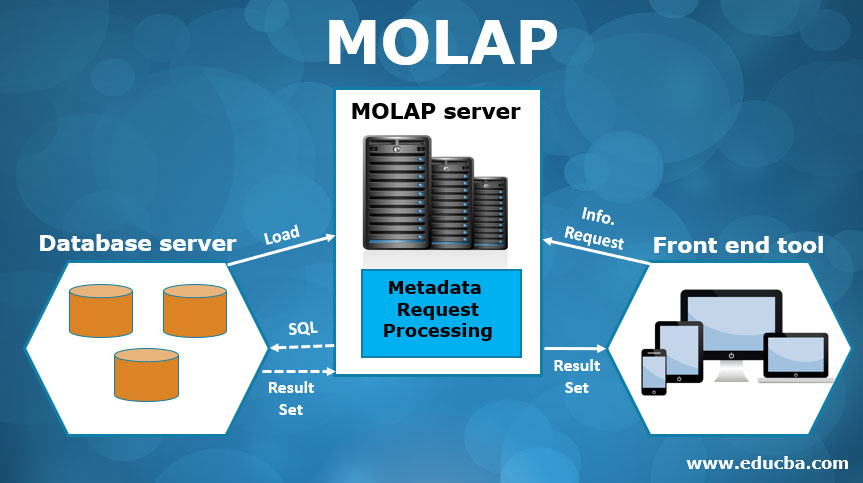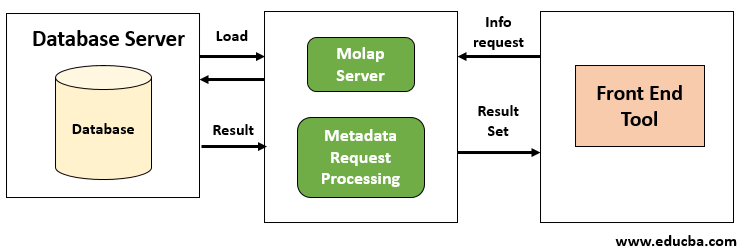Updated March 24, 2023
What is MOLAP?
MOLAP stands for Multidimensional online analytical processing. It is a type of OLAP process which utilizes a multidimensional data model so that analysis of data can be done easily. Data in MOLAP is pre-computed, pre-summarized and is stored in MOLAP. MOLAP has the capability of storing different permutations and combinations of data which is already stored in a multidimensional array. This means it processes the data which is already stored in the defined multidimensional array. All cells of data present can be accessed directly from the array. As a result, MOLAP is faster and gives responses to the analytical data. Let us have a look at MOLAP in more detail.
Architecture of MOLAP
MOLAP architecture consists of the following components which are listed below:
- Database server
- MOLAP server
- Front end tool
Let us now check the architecture in detail
Using the front end tool which is a component in MOLAP architecture, the user can send a request for reports through the interface which is present. Once the information request is sent then comes the application layer. This layer consists of the MOLAP server. The MOLAP server takes the responsibility of metadata request processing. This means the application logic layer of the metadata database retrieves the stored data which is in the database. Once this is retrieved the application layer then forwards the result obtained to the client or user.
MOLAP architecture mainly focuses on precompiled data. This architecture provides a limited number of categories. You can dynamically create aggregations that can help you to have results. These results are those which have not been calculated in advance or they are not stored anywhere. As an example, we can consider that you can generate a report of people having a savings account and current account. These can be done for all customers. The metadata database will retrieve data of both accounts with its user details. Once the results are retrieved it will display the result to the user.
Implementation of MOLAP
When implementing MOLAP it is very important to consider that both maintenance and storage implications have their strategies built. They must have proper building cubes set up so that everything happens in a systematic way. The languages which are used in the implementation of MOLAP are proprietary languages that are used to build queries. MOLAP must have extensive click support and drag support which is provided by for example say MDX by Microsoft. When the cubes are created it is difficult to scale the number and size of cubes as these should be scalable as and when the dimensions change or increase. APIs should be provided in order to probe the cubes available. MOLAP has data structures that support different kinds of subject areas. These areas include data that analyses the data which should be further navigated and analyzed. After the analysis when the navigation changes it is required to change the data structure and reorganize it physically.
This also needs that the person doing this has a different skill set. The tools to be used should also be different and they should maintain the database. MOLAP directly supports multidimensional data and operations. The data is by default stored in a multidimensional array. This provides the user different perspectives od data that can aggregate the sales by time, geography or the product. The storage being used here is not a relational database. If the data were stored in the relational database then it would be difficult to access and process the table for every dimension. MOLAP processes the data which can be easily stored in a multidimensional array. This helps in processing all different combinations which can be reflected easily. These different combinations are already stored and reflected which can be used efficiently. It is more appropriate with cubes which are being used frequently and are a necessity for the query to process rapidly.
MOLAP thus needs less storage as compared to ROLAP where compression techniques create an issue. The data cubes being discussed here are created by extracting data from the databases which are operational or are being used in a database. These data cubes that are created are static and are not subject to any change. The data cubes must be created only before they will be being used. Data cubes cannot be created by using the ad hoc queries and on the go. Hence it is said that they work best with pre-defined queries. Data cubes are thus critical and have a necessity of in detail front end and design work.
Advantages of MOLAP
- MOLAP is well known for its efficient and fast performance. It owes streamlining of indexes and also helps in optimizing the data which is extracted frequently. This data is sliced and diced so that it can easily provide different patterns or views of the information already being present.
- It has the capability of managing and analyzing huge amounts of data which is multidimensional.
- The query performance is quick as the storage is optimized and it has techniques like indexing and caching is used.
- The data is segregated into chunks and is compared to the relational database.
- MOLAP can perform complex calculations with ease. All the calculations are pre-generated when the cube is being created.
- MOLAP has the ability to give all data combinations which it displays in a multidimensional array. Multidimensional OLAP has a processing system which needs less storage
- It is easier to use and hence becomes the reason for a model that can be used by anyone. This especially eases for inexperienced people.
- It makes sure that data being processed is in smaller sizes when compared to relational databases.
Disadvantages of MOLAP
- The main disadvantage of MOLAP is that it is not scalable. It can handle only a limited amount of data at a time. It cannot be increased dynamically.
- The solutions provided by MOLAP can be lengthy when data is in large volumes.
- The storage is not utilized efficiently if the data set being analyzed is scattered.
- MOLAP can handle only small amounts of data and that is the reason why it is not possible to include large amounts of data.
Conclusion
MOLAP is thus an operation that can work with small chunks of data and provide quick and efficient results. It can process the multidimensional array. It can easily manage and analyze huge amounts of multidimensional data.
Recommended Articles
This is a guide to MOLAP. Here we discuss What is MOLAP and its Architecture along with advantages and disadvantages. You may also look at the following articles to learn more –




